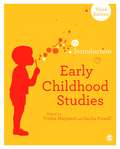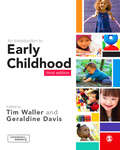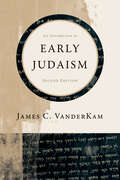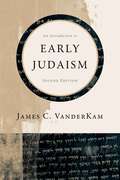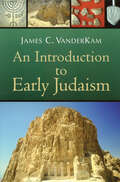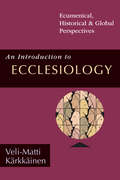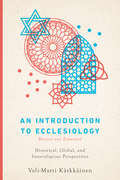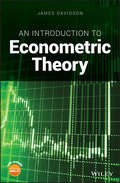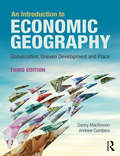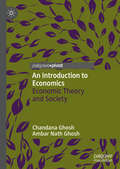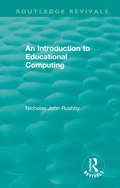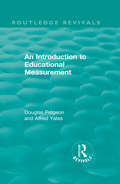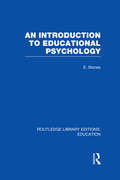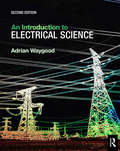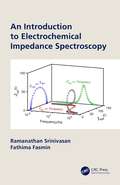- Table View
- List View
An Introduction to Early Childhood Studies
by Sacha Powell Kate SmithThis new edition of this bestselling textbook examines the key themes involved in the study of young children and childhood from a variety of disciplines and international perspectives, making essential links between theory and practice to help you apply your learning in real-life settings. Key additions include: the latest changes in early years policy 2 brand new chapters on Postmodernist theories in Education, and Education for Sustainable Development A renewed emphasis on reflective practice across Part 4, supporting and encouraging your professional development Throughout, case studies, exercises and links to further reading help you engage with key issues and test your learning, making it easier for you to get to grips with all aspects of your course.
An Introduction to Early Childhood Studies
by Sacha Powell Kate SmithThis new edition of this bestselling textbook examines the key themes involved in the study of young children and childhood from a variety of disciplines and international perspectives, making essential links between theory and practice to help you apply your learning in real-life settings. Key additions include: the latest changes in early years policy 2 brand new chapters on Postmodernist theories in Education, and Education for Sustainable Development A renewed emphasis on reflective practice across Part 4, supporting and encouraging your professional development Throughout, case studies, exercises and links to further reading help you engage with key issues and test your learning, making it easier for you to get to grips with all aspects of your course.
An Introduction to Early Childhood Studies
by Trisha Maynard Sacha Powell'An excellent text which offers students a rounded view of early years in the context of political agendas, while still maintaining the child at the centre of provision and understanding.' - Stephanie Evans, University of Cumbria 'Fully up-to-date with an accessible layout and style and a balance between current research, theory and practice, this new edition will prove to be a valuable resource for all students and practitioners.' - Jan Marks, Senior Lecturer, Early Years, University of Chester 'This should be a key text for all studying and teaching in the field of early years.' - Ioanna Paliologou, Centre for Educational Studies, University of Hull This new edition of an iconic book examines the key themes involved in the study of young children and childhood from a variety of disciplines and international perspectives, making essential links between theory and practice to help you apply your learning in real-life settings. Key additions: New chapters on cultural-historical child development and childhood in a digital age Renewed emphasis on reflective practice across Part 4, supporting and encouraging your professional development New Reflection Points encourage deeper discussion and critical reflection, ideal for testing your understanding The latest on changes in early years policy and practice Throughout, case studies, exercises and links to further reading help you engage with key issues and test your learning, making it easier for you to get to grips with all aspects of your course.
An Introduction to Early Childhood: A Multidisciplinary Approach
by Tim Waller Geraldine DavisPut together by an outstanding author team, including many authors from the University of Northampton, An Introduction to Early Childhood is a much loved book that helps you explore all the major themes in early years education and care, while providing you with real insight into the changing world of early childhood. To further support your study, this edition has been expanded to include five new chapters including The History of Childhood, Play and Creativity, Children and the Media, Leadership and Management, and Reflective Practice. This book further supports your study with outstanding learning features including: · Chapter objectives and introduction immediately introduce you to chapter concepts saving you time · More case studies provide deeper insight into how theory works in practice · Research in context boxes show how recent research is changing the world of early years · Reflective questions encourage you to think like a reflective practitioner · Chapter summaries aid your revision by recapping core concepts covered in each chapter · Further reading and recommended websites direct you to additional resources to further support your study. Visit the companion website to access a wealth of additional online resources including: · Podcasts from chapter authors provide deeper insight into key topics · Employability podcasts provide hints and tips about going on your first placement and getting your first job · Child observation videos give you a peek into a real early years setting and insight into child behaviour · Free SAGE journal articles deepen your understanding on core topics · Web links direct you to useful websites to further your study and support you in practice.
An Introduction to Early Judaism
by James C. VanderkamBased on the best archaeological research, this volume explores the history of Judaism during the Second Temple period (516 BCE–70 CE), describing the body of Jewish literature written during these centuries and the most important groups, institutions, and practices of the time. Particularly interesting are VanderKam&’s depiction of events associated with Masada and, more briefly, the Bar Kokhba revolt—as well as his commentary on texts unearthed in places like Elephantine and Qumran. Now in its second edition, with additional material and updated throughout, this book remains the preeminent guide to early Judaism for anyone looking for a text that is concise and accessible while still comprehensive—and written by one of the foremost experts in the field.
An Introduction to Early Judaism
by James C. VanderkamBased on the best archaeological research, this volume explores the history of Judaism during the Second Temple period (516 BCE–70 CE), describing the body of Jewish literature written during these centuries and the most important groups, institutions, and practices of the time. Particularly interesting are VanderKam’s depiction of events associated with Masada and, more briefly, the Bar Kokhba revolt—as well as his commentary on texts unearthed in places like Elephantine and Qumran. <p><p> Now in its second edition, with additional material and updated throughout, this book remains the preeminent guide to early Judaism for anyone looking for a text that is concise and accessible while still comprehensive—and written by one of the foremost experts in the field.
An Introduction to Early Judaism
by James C. VanderkamOne of today's most respected scholars of biblical history and the Dead Sea Scrolls, James C. VanderKam here offers a superb new introduction to early Judaism.Based on the best, most recent archaeological research, this illustrated volume explores the history of Judaism during the Second Temple period (516 B.C.E. - 70 C.E.), describing the body of Jewish literature written during these centuries and the most important groups, institutions, and practices of the time. Particularly interesting are VanderKam's depiction of events associated with Masada and the Kokhba revolt, and his commentary on texts unearthed in places like Elephantine, Egypt, and Qumran.Written in the same accessible style as VanderKam's widely praised Dead Sea Scrolls Today, this volume provides the finest classroom introduction to early Judaism available.
An Introduction to Ecclesiology: Ecumenical, Historical & Global Perspectives
by Veli-Matti KärkkäinenchurchAn Introduction to Ecclesiology
An Introduction to Ecclesiology: Historical, Global, and Interreligious Perspectives
by Veli-Matti Kärkkäinenmajor theological traditions, including Eastern Orthodox, Roman Catholic, Reformed, and Pentecostalecclesiological insights from Latin American, Africa, and Asiadistinct perspectives from women, African Americans, and recent trends in the United Stateskey elements of the church such as mission, governance, worship, and sacramentsinterreligious comparison with Jewish, Islamic, Hindu, and Buddhist communities
An Introduction to Ecological Economics
by Carol Franco Robert Costanza Herman Daly Robert Goodland Richard B Norgaard Ida Kubiszewski John H CumberlandFrom Empty-World Economics to Full-World EconomicsEcological economics explores new ways of thinking about how we manage our lives and our planet to achieve a sustainable, equitable, and prosperous future. Ecological economics extends and integrates the study and management of both "nature's household" and "humankind's household"-An Introduction to
An Introduction to Econometric Theory
by James DavidsonA guide to economics, statistics and finance that explores the mathematical foundations underling econometric methods An Introduction to Econometric Theory offers a text to help in the mastery of the mathematics that underlie econometric methods and includes a detailed study of matrix algebra and distribution theory. Designed to be an accessible resource, the text explains in clear language why things are being done, and how previous material informs a current argument. The style is deliberately informal with numbered theorems and lemmas avoided. However, very few technical results are quoted without some form of explanation, demonstration or proof. The author — a noted expert in the field — covers a wealth of topics including: simple regression, basic matrix algebra, the general linear model, distribution theory, the normal distribution, properties of least squares, unbiasedness and efficiency, eigenvalues, statistical inference in regression, t and F tests, the partitioned regression, specification analysis, random regressor theory, introduction to asymptotics and maximum likelihood. Each of the chapters is supplied with a collection of exercises, some of which are straightforward and others more challenging. This important text: Presents a guide for teaching econometric methods to undergraduate and graduate students of economics, statistics or finance Offers proven classroom-tested material Contains sets of exercises that accompany each chapter Includes a companion website that hosts additional materials, solution manual and lecture slides Written for undergraduates and graduate students of economics, statistics or finance, An Introduction to Econometric Theory is an essential beginner’s guide to the underpinnings of econometrics.
An Introduction to Economic Dynamics: Modelling, Analysis and Simulation (Routledge Advanced Texts in Economics and Finance)
by Srinivas Raghavendra Petri T. PiiroinenAn Introduction to Economic Dynamics provides a framework for students to appreciate and understand the basic intuition behind economic models and to experiment with those models using simulation techniques in MATLAB®. This book goes beyond the often-limited scope of other texts on economic models, which have largely focused on elucidating static equilibrium models. Comparative static analysis inhibits students from asking how the equilibrium position is achieved from an initial out-of-equilibrium position and limits their understanding of the dynamics that underlie such analysis. In this textbook, readers are introduced to ten well-established macroeconomic models – including Keynesian multiplier models, Samuelson’s multiplier and Solow’s growth model – and guided through the dynamical systems behind each model. Every chapter begins with an overview of the economic problem which the model is designed to help solve followed by an explanation of the mathematics of the model. Solutions are provided using simulation and visualisation techniques in MATLAB®, which are interwoven organically with the analysis and are introduced in a step-by-step fashion to guide the reader along the way. Appendices provide an introduction to MATLAB® along with all the necessary codes. The book is ideally suited for courses in economic dynamics, macroeconomic modelling and computational economics, as well as for students of finance, mathematics and engineering who are interested in economic models.
An Introduction to Economic Geography: Globalisation, Uneven Development and Place
by Andrew Cumbers Danny MacKinnonIn the context of great economic turmoil and uncertainty, the emergent conflict between continued globalisation and growing economic nationalism means that a geographical economic perspective has never been so important. An Introduction to Economic Geography guides students through the key debates of this vibrant area, exploring the range of ideas and approaches that invigorate the wider discipline. This third edition includes new chapters on finance, cities and the digital economy, consumption and the environment. Underpinned by the themes of globalisation, uneven development and place, the text conveys the diversity of contemporary economic geography and explores the social and spatial effects of global economic restructuring. It combines a critical geographical perspective on the changing economic landscape with an appreciation of contemporary themes such as neoliberalism, financialisation, innovation and the growth of new technologies. An Introduction to Economic Geography is an essential textbook for undergraduate students taking courses in Economic Geography, Globalisation Studies and more broadly in Human Geography. It will also be of much interest to those in Planning, Business and Management Studies and Economics.
An Introduction to Economics
by Berkeley HillThis book provides a simple but effective introduction to economics. Fully updated and revised, this fourth edition incorporates the recent changes that have taken place in the environment in which agriculture operates. Covering the impacts of the EU expansion to 28 Member States, major changes to financial support of agriculture, financial crises, economic recession and, in many countries, high levels of unemployment, it provides a rounded and up to date introduction to the subject. The inclusion of chapter-focused exercises, essay questions and further reading suggestions make this textbook an invaluable learning tool for students of agriculture, economics and related sectors.
An Introduction to Economics: Concepts for Students of Agriculture and the Rural Sector
by Berkeley HillUpdated and revised, this fifth edition incorporates recent developments in the environment in which agriculture operates. Issues that have gained prominence since the previous edition (2014) include climate change and agriculture's mitigating role, concern with animal welfare, the social contributions that agriculture makes, risks associated with globalization, and rising concern over sustainability. Important for UK and EU readers are the adjustments needed now that the UK is no longer a member of the European Union and the nature of the national policies developed to replace the EU's Common Agricultural Policy. Containing all the major economic principles with agriculture-specific examples, An Introduction to Economics, 5th Edition provides a rounded and up-to-date introduction to the subject. The inclusion of updated chapter-focused exercises, essay questions and suggestions for further reading make this textbook an invaluable learning tool. This book: Is updated to include new developments, such as Brexit, importance of climate change and animal welfare. Includes exercises and essay questions. Suggests further reading to supplement the text. This book is recommended for students of agriculture, economics and related sectors.
An Introduction to Economics: Economic Theory and Society
by Ambar Nath Ghosh Chandana GhoshThe book compares neoclassical and Marxian economics and points out that both the schools of thought seek to analyze how a capitalist society functions. The authors show that the neoclassical economics vindicates capitalism and prescribes policies that further the interest of the rich (giant capitalists), who own most of the non-human productive resources of the economy, whereas Marxian analysis yields the result that a capitalist society is exploitative and crisis-prone. Marxian economics also suggests that the class struggle inherent in a capitalist society will eventually transform it into an equal, just and humane socialist societyThe book also presents Keynesian theory, which suggests measures that can counter at least some of the crises that Marx said a capitalist country is subject to. It discusses the current state of the capitalist world, the recent crises it was subject to and assesses the three theories in the light of these experiences. It recounts the current states of two important socialist states, namely, China and Cuba. It discusses the economic performance of Soviet Union since its birth and explains the reasons for its disintegration. It compares economic performances of the capitalist and the socialist states and assesses in the light of the experiences of these two blocs of countries which school of thought is more acceptable and closer to the truth.
An Introduction to Educational Computing (Routledge Revivals)
by Nicholas John RushbyIn both education and training, teachers are faced with many and varied problems relating to their teaching and their students’ learning. Educational technology, in its widest sense, provides teachers with methods and tools which, if properly used, can alleviate some of these problems. The computer is one such tool, offering, within certain limitations, some possible solutions. Originally published in 1979, this book describes the use of the computer as a resource and as a manager in education and training. It discusses the use, potential and limitations of this technology in helping the teacher and trainer. Beginning with a consideration of the role of the computer as a mediator in the flow of information between the student and his learning environment, the book goes on to look at Computer Assisted Learning from an educational viewpoint, the strength and weaknesses of a number of different media, and the problems of managing modular courses and course structures and handling information on students’ performance and progress. A chapter on informatics and education addresses the problem of what both teachers and students should know about computers, while the final chapter examines the practical problems of prompting and organising the appropriate use of this technology.
An Introduction to Educational Measurement (Routledge Revivals)
by Douglas Pidgeon Alfred YatesOriginally published in 1968, at a time when the current public examination systems were coming under close scrutiny this volume discusses completely and fully the merits and demerits of various methods of educational measurement, starting with the theories from which they evolved and going on to observe their efficacy in practice. School-based systems of measurement are also studied, both as separate entities and in comparison with the public examinations at 11+, CSE and ‘O’ and ‘A’-levels of the GCE. The subject-matter of this book was intended to affect students, practising teachers and educationists and, whatever their views, they were able to use the authors’ exposition of this controversial subject as a starting point for further and deeper discussion.
An Introduction to Educational Psychology (Routledge Library Editions: Education)
by Edgar StonesThis book introduces students of education to the elements of educational psychology. It also relates as closely as possible the findings of research to classroom practice. In order to make clear the fundamental processes involved in psychological development, the book starts with a study of the way in which the young child adapts its behaviour to its environment. This study considers some of the key aspects of physical development, mainly the central nervous system. At the same time the way physical growth and psychological development are influenced by the experience of the individual is also discussed. This discussion of development is followed by an examination of the processes of learning, with particular attention paid to the works of Piaget. The salient points of each chapter are brought together in a summary which may be used by the reader to obtain a preliminary overview of the content of the chapter, and as an aid to revision.
An Introduction to Educational Research: Connecting Methods to Practice
by Jessica Nina Lester Chad LochmillerExpand your understanding of educational research with this practice-first introduction. Written specifically for education practitioners, An Introduction to Educational Research: Connecting Methods to Practice approaches research methods from a practice-first perspective that aligns research with professional experiences and identifies the tools and resources readers can use when conducting their own research. Throughout the book, the authors illuminate complex research concepts using problems of practice confronting educators to help readers make meaningful connections with key concepts and research practices. The authors present balanced coverage across research methodologies that is linked to practice, so readers clearly see research as a tool they can use to improve classrooms, schools, districts, and educational organizations.
An Introduction to Educational Research: Connecting Methods to Practice
by Jessica Nina Lester Chad LochmillerExpand your understanding of educational research with this practice-first introduction. Written specifically for education practitioners, An Introduction to Educational Research: Connecting Methods to Practice approaches research methods from a practice-first perspective that aligns research with professional experiences and identifies the tools and resources readers can use when conducting their own research. Throughout the book, the authors illuminate complex research concepts using problems of practice confronting educators to help readers make meaningful connections with key concepts and research practices. The authors present balanced coverage across research methodologies that is linked to practice, so readers clearly see research as a tool they can use to improve classrooms, schools, districts, and educational organizations.
An Introduction to Electrical Science
by Adrian WaygoodAn Introduction to Electrical Science walks readers through the subject in a logical order, providing a historical overview alongside modern electrical theory and practice. Perfect for electrical trainees both during their training and once qualified. You will be guided through the subject in a topic by topic manner with each section building upon the one that came before it. By adding context to the principles of electrical science the topics become easier to both understand and remember, providing a grounding in the subject that will remain with you for life. With a wealth of examples, images and diagrams mastering difficult concepts will be a breeze. This book also has a companion site with an extra chapter, interactive multiple choice quizzes for each chapter and more at www.www.routledge.com/cw/waygood Fully aligned to the 17th edition of the wiring regulations Free access to companion website material, including multiple-choice tests and extra chapters Two-colour layout helps navigation and highlights key points Visit the companion website at www.routledge.com/cw/waygood
An Introduction to Electrical Science
by Adrian WaygoodHeavily updated and expanded, this second edition of Adrian Waygood’s textbook provides an indispensable introduction to the science behind electrical engineering. While fully matched to the electrical science requirements of the 2330 levels 2 and 3 Certificates in Electrotechnical Technology from City & Guilds (Electrical Installation), the main purpose of this book is to develop an easy understanding of the how and why within each topic. It is aimed at those starting careers in electricity and electronics, as well as any hobbyists, with an array of new material to reflect changes in the industry. New chapters include: Electrical drawings Practical resistors Measuring instruments Basic motor action Practical capacitors Basic transformer theory The electricity supply industry …and more The author details the historical context of each main principle and offers a wealth of examples, images and diagrams, all whilst maintaining his signature conversational and accessible style. There is also a companion website, with interactive multiple choice quizzes for each chapter and more, at www.routledge.com/cw/waygood
An Introduction to Electrochemical Impedance Spectroscopy
by Ramanathan Srinivasan Fathima FasminThis book covers the fundamental aspects and the application of electrochemical impedance spectroscopy (EIS), with emphasis on a step-by-step procedure for mechanistic analysis of data. It enables the reader to learn the EIS technique, correctly acquire data from a system of interest, and effectively interpret the same. Detailed illustrations of how to validate the impedance spectra, use equivalent circuit analysis, and identify the reaction mechanism from the impedance spectra are given, supported by derivations and examples. MATLAB® programs for generating EIS data under various conditions are provided along with free online video lectures to enable easier learning. Features: Covers experimental details and nuances, data validation method, and two types of analysis – using circuit analogy and mechanistic analysis Details observations such as inductive loops and negative resistances Includes a dedicated chapter on an emerging technique (Nonlinear EIS), including code in the supplementary material illustrating simulations Discusses diffusion, constant phase element, porous electrodes, and films Contains exercise problems, MATLAB codes, PPT slide, and illustrative examples This book is aimed at senior undergraduates and advanced graduates in chemical engineering, analytical chemistry, electrochemistry, and spectroscopy.
An Introduction to Electronic Art Through the Teaching of Jacques Lacan: Strangest Thing
by David Bard-SchwarzElectronic art offers endless opportunities for reflection and interpretation. Works can be interactive or entirely autonomous and the viewer's perception and reaction to them may be challenged by constantly transforming images. Whether the transformations are a product of the appearances or actions of a viewer in an installation space, or a product of a self-contained computer program, is a source of constant fascination. Some viewers may feel strange or unnerved by a work, while others may feel welcoming, humorous, and playful emotions. The art may also provoke a critical response to social, aesthetic, and political aspects of early twenty-first-century life. This book approaches electronic art through the teachings of Jacques Lacan, whose return to Freud has exerted a powerful and wide-ranging influence on psychoanalysis and critical theory in the twentieth century. David Bard-Schwarz draws on his experience with Lacanian psychoanalysis, music, and interactive and traditional arts in order to address aspects of the works the viewer may find difficult to understand. Dividing his approach over four thematic chapters—Bodies, Voices, Eyes, and Signifiers—Bard-Schwarz explores the links between works of new media and psychoanalysis (how we process what we see, hear, touch, imagine, and remember). This is a fascinating book for new media artists and critics, museum curators, psychologists, students in the fine arts, and those who are interested in digital technology and contemporary culture.

